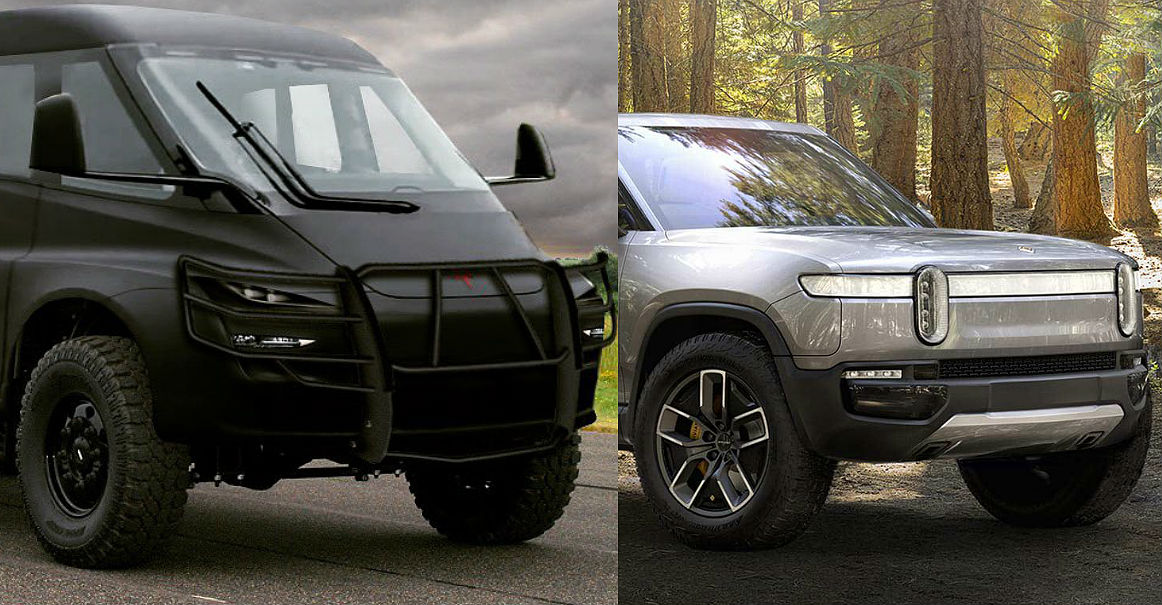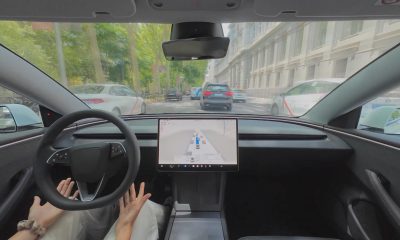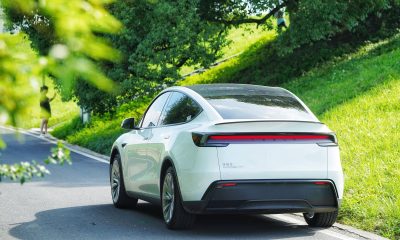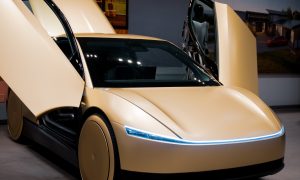

News
Tesla’s pickup truck and Rivian’s R1T can topple the mighty Ford F-150
The mighty Ford F-150 might see a legitimate challenge in the near future, if the veteran automaker neglects to prepare adequately for the arrival of two all-electric pickup trucks on the market — the Tesla Truck and the Rivian R1T.
The disruption of battery-powered pickup trucks was highlighted in a note from Morgan Stanley analyst Adam Jonas on Thursday. Addressing the firm’s investors, the analyst stated that an electric pickup successfully launched by a new player like Tesla or Rivian “could be a serious problem for the Detroit-based traditional automakers.” With the arrival of compelling vehicles, Jonas noted that experienced carmakers like Ford could lose the opportunity to gain a “first mover advantage” in the electric pickup market.
Promising Challengers

The Wall St analyst’s points hit the nail on the head, considering that the innate characteristics of electric vehicles such as instant torque and generous towing capacity are factors that are vital to the pickup truck market. The Rivian R1T, for example, is listed with a towing capacity of 11,000 pounds, though CEO RJ Scaringe noted in a recent interview that the truck could tow far beyond its official rating. Thanks to the R1T’s four electric motors, the truck is also able to hit 60 mph in just 3 seconds.
The Tesla Truck, on the other hand, has been mentioned several times by Elon Musk in recent months. Last year, Musk held a Twitter brainstorming session with his social media followers to list down features that are important for pickup truck owners. By the end of the session, Musk noted that the Tesla Truck would have two electric motors and dynamic suspension, a range of 400-500 miles per charge, four-wheel steering, a 240-volt connection for heavy-duty tools, and even an air compressor to run other equipment. Musk also noted that the vehicle could tow as much as 300,000 pounds.
Tesla’s Acid Test

Anyone skeptical of the potential disruption from an electric vehicle does not need to look very far. Over the past year, Tesla’s Model 3 midsize sedan all but shook the United States’ passenger car market, creeping up on ubiquitous vehicles like the Toyota Camry and dominating in revenue rankings. By the end of 2018, the Model 3 was the US’ best-selling luxury vehicle, despite being a sedan in a market that prefers SUVs and pickup trucks.
With a battery-powered pickup truck that is reasonably priced and well-equipped with features, carmakers such as Tesla and Rivian could challenge even the US auto industry’s biggest sellers, including the Ford F-150. One thing that would be a hindrance to this potential disruption, of course, would be the capability of electric car makers to scale production, especially considering the demand for pickups in the US. In this light, Rivian must still prove itself, since the production of the R1T is yet to begin. Tesla, on the other hand, is already learning the art of mass production, as shown by its growing pains with the Model 3 ramp.
A Way to Maintain the Status Quo

Despite the upcoming challenge and Wall Street’s recent warning, Ford does have a way to maintain the status quo in the pickup truck market. Last month, Jim Farley, Ford’s president of global markets, announced that the F-series would be going electric. Farley later added that the decision to adopt all-electric and hybrid power is a way to “future-proof” the company’s most successful vehicle line.
If recent sightings are any indication, it appears that Ford is at least testing an electric prototype of the F-150. As noted in a recent sighting, a camouflaged electric F-150 has been spotted charging at a station. The vehicle looked a lot like a regular truck, save for its charging port and its higher ride height, which appeared to be the result of batteries installed underneath the vehicle. Provided that Ford does not show some ill-timed hubris by giving the electric F-150 mediocre specs and range, the company could very well weather the storm of electric trucks coming its way.
Elon Musk
Why Tesla’s Q3 could be one of its biggest quarters in history
Tesla could stand to benefit from the removal of the $7,500 EV tax credit at the end of Q3.

Tesla has gotten off to a slow start in 2025, as the first half of the year has not been one to remember from a delivery perspective.
However, Q3 could end up being one of the best the company has had in history, with the United States potentially being a major contributor to what might reverse a slow start to the year.
Earlier today, the United States’ House of Representatives officially passed President Trump’s “Big Beautiful Bill,” after it made its way through the Senate earlier this week. The bill will head to President Trump, as he looks to sign it before his July 4 deadline.
The Bill will effectively bring closure to the $7,500 EV tax credit, which will end on September 30, 2025. This means, over the next three months in the United States, those who are looking to buy an EV will have their last chance to take advantage of the credit. EVs will then be, for most people, $7,500 more expensive, in essence.
The tax credit is available to any single filer who makes under $150,000 per year, $225,000 a year to a head of household, and $300,000 to couples filing jointly.
Ending the tax credit was expected with the Trump administration, as his policies have leaned significantly toward reliance on fossil fuels, ending what he calls an “EV mandate.” He has used this phrase several times in disagreements with Tesla CEO Elon Musk.
Nevertheless, those who have been on the fence about buying a Tesla, or any EV, for that matter, will have some decisions to make in the next three months. While all companies will stand to benefit from this time crunch, Tesla could be the true winner because of its sheer volume.
If things are done correctly, meaning if Tesla can also offer incentives like 0% APR, special pricing on leasing or financing, or other advantages (like free Red, White, and Blue for a short period of time in celebration of Independence Day), it could see some real volume in sales this quarter.
You can now buy a Tesla in Red, White, and Blue for free until July 14 https://t.co/iAwhaRFOH0
— TESLARATI (@Teslarati) July 3, 2025
Tesla is just a shade under 721,000 deliveries for the year, so it’s on pace for roughly 1.4 million for 2025. This would be a decrease from the 1.8 million cars it delivered in each of the last two years. Traditionally, the second half of the year has produced Tesla’s strongest quarters. Its top three quarters in terms of deliveries are Q4 2024 with 495,570 vehicles, Q4 2023 with 484,507 vehicles, and Q3 2024 with 462,890 vehicles.
Elon Musk
Tesla Full Self-Driving testing continues European expansion: here’s where
Tesla has launched Full Self-Driving testing in a fifth European country ahead of its launch.

Tesla Full Self-Driving is being tested in several countries across Europe as the company prepares to launch its driver assistance suite on the continent.
The company is still working through the regulatory hurdles with the European Union. They are plentiful and difficult to navigate, but Tesla is still making progress as its testing of FSD continues to expand.
Today, it officially began testing in a new country, as more regions open their doors to Tesla. Many owners and potential customers in Europe are awaiting its launch.
On Thursday, Tesla officially confirmed that Full Self-Driving testing is underway in Spain, as the company shared an extensive video of a trip through the streets of Madrid:
Como pez en el agua …
FSD Supervised testing in Madrid, Spain
Pending regulatory approval pic.twitter.com/txTgoWseuA
— Tesla Europe & Middle East (@teslaeurope) July 3, 2025
The launch of Full Self-Driving testing in Spain marks the fifth country in which Tesla has started assessing the suite’s performance in the European market.
Across the past several months, Tesla has been expanding the scope of countries where Full Self-Driving is being tested. It has already made it to Italy, France, the Netherlands, and Germany previously.
Tesla has already filed applications to have Full Self-Driving (Supervised) launched across the European Union, but CEO Elon Musk has indicated that this particular step has been the delay in the official launch of the suite thus far.
In mid-June, Musk revealed the frustrations Tesla has felt during its efforts to launch its Full Self-Driving (Supervised) suite in Europe, stating that the holdup can be attributed to authorities in various countries, as well as the EU as a whole:
Tesla Full Self-Driving’s European launch frustrations revealed by Elon Musk
“Waiting for Dutch authorities and then the EU to approve. Very frustrating and hurts the safety of people in Europe, as driving with advanced Autopilot on results in four times fewer injuries! Please ask your governing authorities to accelerate making Tesla safer in Europe.”
Waiting for Dutch authorities and then the EU to approve.
Very frustrating and hurts the safety of people in Europe, as driving with advanced Autopilot on results in four times fewer injuries!
Please ask your governing authorities to accelerate making Tesla safer in Europe. https://t.co/QIYCXhhaQp
— Elon Musk (@elonmusk) June 11, 2025
Tesla said last year that it planned to launch Full Self-Driving in Europe in 2025.
Elon Musk
xAI’s Memphis data center receives air permit despite community criticism
xAI welcomed the development in a post on its official xAI Memphis account on X.

Elon Musk’s artificial intelligence startup xAI has secured an air permit from Memphis health officials for its data center project, despite critics’ opposition and pending legal action. The Shelby County Health Department approved the permit this week, allowing xAI to operate 15 mobile gas turbines at its facility.
Air permit granted
The air permit comes after months of protests from Memphis residents and environmental justice advocates, who alleged that xAI violated the Clean Air Act by operating gas turbines without prior approval, as per a report from WIRED.
The Southern Environmental Law Center (SELC) and the NAACP has claimed that xAI installed dozens of gas turbines at its new data campus without acquiring the mandatory Prevention of Significant Deterioration (PSD) permit required for large-scale emission sources.
Local officials previously stated the turbines were considered “temporary” and thus not subject to stricter permitting. xAI applied for an air permit in January 2025, and in June, Memphis Mayor Paul Young acknowledged that the company was operating 21 turbines. SELC, however, has claimed that aerial footage shows the number may be as high as 35.
Critics are not giving up
Civil rights groups have stated that they intend to move forward with legal action. “xAI’s decision to install and operate dozens of polluting gas turbines without any permits or public oversight is a clear violation of the Clean Air Act,” said Patrick Anderson, senior attorney at SELC.
“Over the last year, these turbines have pumped out pollution that threatens the health of Memphis families. This notice paves the way for a lawsuit that can hold xAI accountable for its unlawful refusal to get permits for its gas turbines,” he added.
Sharon Wilson, a certified optical gas imaging thermographer, also described the emissions cloud in Memphis as notable. “I expected to see the typical power plant type of pollution that I see. What I saw was way worse than what I expected,” she said.
-

 Elon Musk3 days ago
Elon Musk3 days agoTesla investors will be shocked by Jim Cramer’s latest assessment
-

 News1 week ago
News1 week agoTesla Robotaxi’s biggest challenge seems to be this one thing
-

 News2 weeks ago
News2 weeks agoTexas lawmakers urge Tesla to delay Austin robotaxi launch to September
-

 Elon Musk2 weeks ago
Elon Musk2 weeks agoFirst Look at Tesla’s Robotaxi App: features, design, and more
-

 Elon Musk2 weeks ago
Elon Musk2 weeks agoxAI’s Grok 3 partners with Oracle Cloud for corporate AI innovation
-

 News2 weeks ago
News2 weeks agoSpaceX and Elon Musk share insights on Starship Ship 36’s RUD
-

 News2 weeks ago
News2 weeks agoWatch Tesla’s first driverless public Robotaxi rides in Texas
-

 News2 weeks ago
News2 weeks agoTesla has started rolling out initial round of Robotaxi invites














